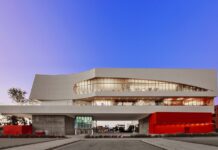A new project from researchers at the University of California, Riverside, aims to improve independence for children with cerebral palsy and other physical disabilities. Cerebral palsy is a group of neurological disorders that affect movement, coordination, and muscle tone and is considered the most common cause of serious physical disability in childhood. Those living with cerebral palsy require assistance for daily tasks, and the development of robotic technology has made significant strides in improving their quality of life. UC researchers have begun development of a soft robotic sleeve, which aims to assist with arm movements, enabling the wearer to perform tasks such as opening doors and brushing their teeth.
The project is led by principal investigator, assistant professor Jonathan Realmuto of UCR’s Department of Mechanical Engineering, who specializes in developing theoretical and engineering principles for human-robot systems with applications towards restoring and enhancing human mobility and perception. He is accompanied by co-principal investigators Jun Sheng, an assistant professor of mechanical engineering at UCR and clinical partner Terry Sanger, a pediatric neurologist and computational neuroscientist at Children’s Hospital in Orange County and professor at UCI.
Enabled by a $1.5 million grant from the National Science Foundation, the project is under the solicitation of the National Robotics Initiative 3.0 where research is focused on human robot systems. Particular interest is placed in how robots enhance or augment people’s physical abilities. Funding began in October, 2022 and lasts for 4 years till November, 2026. The first set of human experiments are scheduled to begin in Summer of this year, with the first prototype currently in development and many versions anticipated throughout the development cycle.
Realmuto had developed wearable robots for years prior to coming to UCR, working at USC with Sanger who specialized in pediatric movement disorders. However, with this project, Realmuto hopes to scale up the project from 1 degree of freedom and develop a full robot sleeve for the whole arm. “Our vision is developing these low cost, robotic sleeves that can be worn and help an individual move inside their home, or even outside their home.”
“The idea is to produce technology that would eventually be used all the time. 24 hours a day, or whenever someone is interacting with the world,” Realmuto responded when asked about the sleeves’ daily usage. He explained that while the researchers won’t be sending robots home with people, a series of experiments will ensure the prototype robotic sleeves developed actually enhance the abilities of the wearer.
The team of researchers leveraged a popular type of robot called Soft Robots, which are devices made of soft materials. Realmuto explained, “Soft Robots are inherently safer to have interactions with humans because of this soft property. However, this soft-property acts as a double edged sword which makes them more complicated to control.”
Realmuto’s team has developed algorithms and techniques that use textiles to create low-cost and high-power actuators. “The specific algorithm solves an issue of how do you know how to activate the wearable actuators in a way that provides the user with assistance. This was a big challenge. One of the more popular ways to do this is to use Electromyography sensors to detect muscle activation of the user and use that information to inform the controller on how the actuators should behave. This works well with rigid motors but the challenge is converting this to the soft-actuator approach. The algorithm solves this issue.”
The algorithm is inspired by a biology theory known as the Equilibrium point hypothesis, where any two joints on the body are controlled by two contractile actuators. The elbow for example is controlled by the bicep and tricep and the activation level of both muscles determines the equilibrium of the joint. “Our algorithm essentially takes in the human muscle behavior and outputs the proper equilibrium point of our robot. That’s the basic idea of how it works.”
Professor Sheng’s role in the project is to incorporate shape-memory alloy or smart materials into the previously developed smart actuators to enhance their mechanical modulation properties. They have also leveraged smart materials, such as shape-memory alloys, to enhance mechanical modulation.
The device uses soft actuators, which are made of flexible and stretchable fabrics in order to take advantage of material properties. Part of the first prototype is made to help with wrist rotation. The lines in the fabric are a knit elastic on the top which can stretch in a single direction, The bottom is made from a nylon weave which cannot stretch at all. The garments will contain sealed, airtight regions that can inflate, making them temporarily rigid, and providing the force for movement. “When we inflate the bladder, part of the material wants to stretch and the other wants to not stretch. Because the fibers are at an angle, it’ll do a twist. The twist can help us do wrist rotation,” Realmuto clarified.
The research team aims to test the device on a larger scale, asking participants for feedback and making adjustments accordingly to both the prototype and testing protocols. The project team plans to hold annual meetings at the hospital for each of the four years of development, with workshops scheduled to coincide with the testing schedule. These meetings will include patients and their families, as well as occupational therapists, to gather feedback on the technology as it develops. Safeguards have been implemented in order to prevent the risk of any injury occurring from the sleeve or the algorithm.
The project’s ultimate goal is to create a device that provides long-term daily assistance for children with cerebral palsy, enhancing their independence and improving their ability to interact with the world. Realmuto also hopes for the longevity of the project to translate into further advancement, including development of a similar project for adults with disabilities. “My vision would be some type of technology transfer, or commercialization from the output of this proposal. I hope it can translate into commercial devices but the route to that is complicated but can be done with a follow-up proposal.” In regards to the impact of the project, “If our project is successful, I think we will change how exoskeletons and wearable robots are designed and thought about.”
To learn more about the project or to get involved with development, feel free to contact Professor Realmuto via his email address, jrealmuto@ucr.edu.








